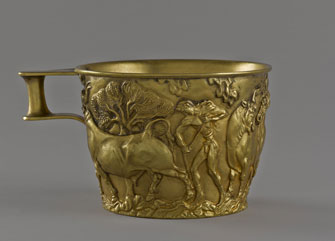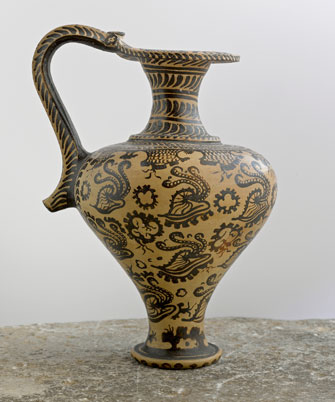Archaic Precursors to
Classical Greece

Anthropomorphic vase (2600-1800 BCE) from Troy II-V. © RMN-Grand Palais (Musée du Louvre)/Franck Raux
The impressive, oft-renovated Château de Saint Germain en Laye, dramatically outlined against the sky, has no lavishly furnished period rooms to visit, but it is still “easy to imagine Louis XIV dancing” in this former royal castle not far from Paris, says Fabien Durand, director of communications for the Musée d’Archéologie Nationale, which is housed in the château.
At the moment, the museum is hosting an exhibition entitled “La Grèce des Origines: Entre Rêve et Archéologie,” which takes a rare look at the neglected prehistory of Greece, whose classical past has been so well documented and celebrated. In fact, as the exhibition points out, prehistoric artifacts were so undervalued at one time – Stone Age axes and amulets dug up by peasants were considered primitive, even barbaric – that the Greek government was in the habit of freely handing out Cycladic antiquities as gifts, something that is hard to imagine today.
The exhibition begins in the château’s 13th-century chapel, which served as the prototype for Sainte-Chapelle in Paris and was probably built by the same unknown architect. The show is not so much a straightforward presentation of prehistoric Greece as it is a look at the 19th-century origins of the practice of archaeology, with the spotlight on digs conducted by the Frenchman Ferdinand Fouqué; Heinrich Schliemann, a rich German amateur obsessed with finding the historic site of Troy; and British archaeologist Arthur Evans.
Fouqué, who excavated on Santorini after the eruption of the island’s volcano in 1866, thought that he had found a “barbaric” Greek version of Pompeii. The lovely drawings of objects found later on this site – similar to some discovered in Crete 40 years later – by two other Frenchmen, Henri Gorceix and Henri Mamet, provide the only record

Drawing (1870-73) of carafes found on Santorini by Henri Gorceix and Henri Mamet.
of many of them. Some of the objects themselves are on display, serving as evidence of how accurate the drawings are. This major discovery was soon forgotten, eclipsed by war and the overriding interest in Classical Greece, and it took another century before attention was once again focused on it.
Schliemann’s search for Troy and other excavations in Greece provide numerous fantastic objects, many of them represented here by high-quality reproductions – one is the stunning gold mask from Mycenae that Schliemann mistook for a representation of

An 1894 reproduction of a Vaphio Cup. The original dates from 1600-1500 BCE. © Rmn-Grand Palais (Musée d’Archéologie Nationale)/Franck Raux
Agamemnon – because the originals are no longer allowed to leave Greece. Schliemann made many other mistakes – he thought, for example, that the female anthropomorphic vases like the one pictured at the top of this page represented owls associated with Athena. Perhaps his greatest mistake, however, was using dynamite in his excavations and possibly destroying many other artifacts.
The show covers several other digs and includes a collection of Minoan seals and fine reproductions of some wonderful pieces found by Arthur Evans, among them Minoan snake goddess figurines. French excavations of Neolithic societies in the Balkans are also covered. The show ends with a display of 20th-century interpretations of ancient Greek motifs by artists, clothing designers and theater designers, among them Gabriele d’Annunzio, Marion Fortuny and Léon Bakst.
The ancient objects themselves range from truly primitive-looking to sophisticated – this Minoan vase of mysterious origins is one

Minoan vase (1575-1475 BCE), decorated with sea creatures, whose exact origins remain a mystery. © Musées de Marseille/David Giancatarina
example – that even the Classical Greeks might not be ashamed to claim them as their own.
If you go, plan to leave time for a walk in the château’s formal garden, designed by André Le Nôtre, with its terrace overlooking the Seine Valley and a distant view of Paris.
Musée d’Archéologie Nationale: Château de Saint-Germain-en-Laye. Take RER line A to Saint-Germain-en-Laye (20 minutes from Charles de Gaulle/Étoile); the château is right next to the station. Open Wednesday-Monday, 10am–5pm. Closed Tuesday. Admission: €9. Through January 19, 2015. www.musee-archeologienationale.fr
Click here to read all of this week’s new articles on the Paris Update home page.
Reader Reaction: Click here to respond to this article (your response may be published on this page and is subject to editing).
Support Paris Update by ordering books from Paris Update’s Amazon store at no extra cost. Click on your preferred Amazon location: U.K., France, U.S.
© 2014 Paris Update
Favorite